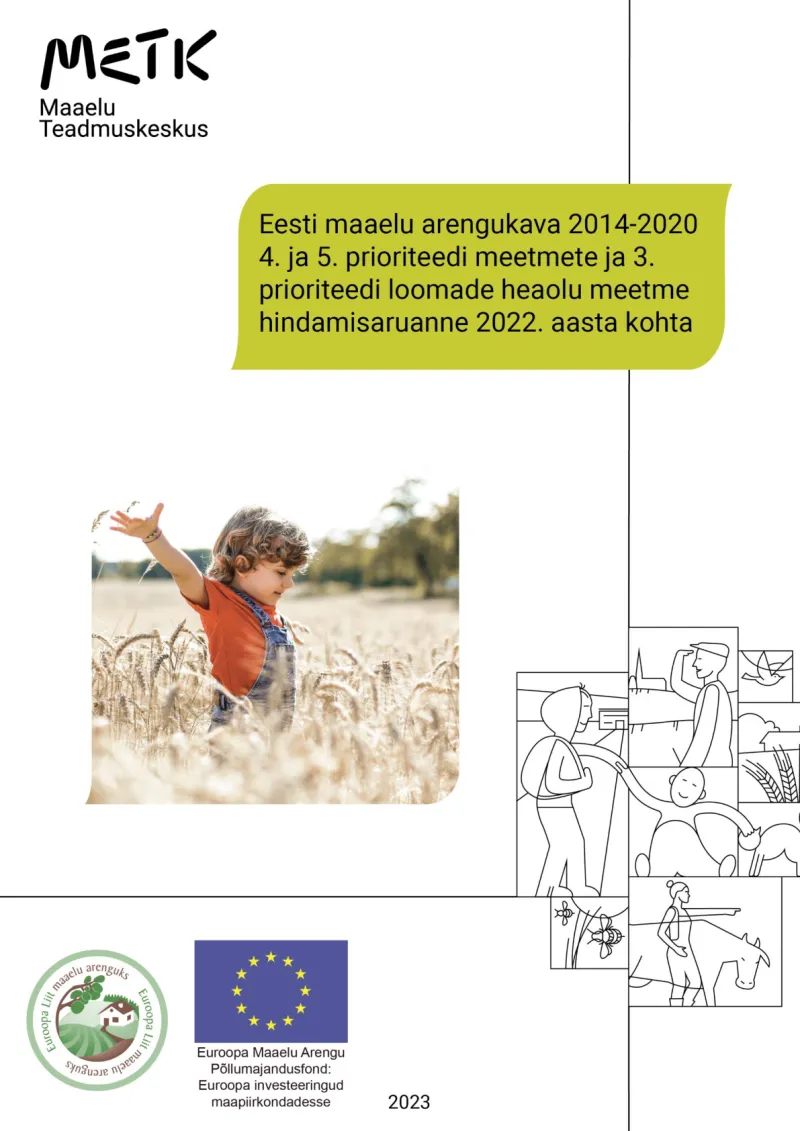Evaluation report on specific measures of Estonia's 2014-2020 Rural Development Programme
- Evaluation
- Environment
- Agricultural Productivity
- Climate and Climate Change
- Sustainability
- Evaluation
The report provides an overview of the assessment of measures related to Priority 4 and 5 of Estonia's 2014-2020 Rural Development Programme, as well as measures related to animal welfare.
- Estonia
- 2014-2022
- Environmental impacts

The report provides an overview of the assessment of measures related to the Rural Development Programme (RDP) Priority 4, 'Restoring, Preserving and Enhancing Ecosystems', and Priority 5, 'Resource-efficient, Climate-resilient Economy', as well as the measure 'Animal Welfare' under Priority 3, 'Food Chain Organisation and Risk Management'. The study was conducted to collect necessary information and background data for assessing measures and for more in-depth analysis. The assessment aims to examine the progress of the development programme in relation to its objectives, using output and, if necessary, impact indicators. The aim is also to propose improvements to the development programme, thereby enhancing the quality of support implementation. Monitoring and evaluation throughout the programme period are conducted continuously and consistently to ensure the availability of data over time.
The analysis describes supported areas at the regional and national levels, the number of beneficiaries, land use, potential supported units, the combined effects of measures with other measures under Priorities 4 and 5, and conclusions drawn from sectoral studies regarding the potential impacts of measures on soil, water, biodiversity and climate. Assessments include time series, comparisons with previous years and periods, trends presented in charts and graphs, and detailed numerical data provided in tables in the annexes of the report.
In the progress report, detailed overviews are provided of the RDP interventions related to Priorities 4 and 5. The main agri-environmental-climate (AEC) measure, environmentally friendly management (EFM), supported an area reaching up to 96% of the target of 475 000 hectares set in the RDP. In Estonia as a whole, the EFM covered 65% of the area under an area-based decoupled payment scheme.
Regarding the organic farming measure (M11), it was found that the extensive area of permanent and short-term grasslands in organic farming enables Estonian organic fields as a whole to maintain and increase soil organic matter content, improve soil structure and prevent the leaching of nutrients. However, the total area of organic grasslands (permanent and short-term) has significantly decreased over the years (from 74% in 2009-2013 to 59% in 2022), while the proportion of cereal and fibre crops has increased (from 22% in 2009-2013 to 39%). The proportion of permanent grasslands among organic producers is decreasing, while the proportion of cereal, oil and fibre crops is increasing, likely due to the conversion of permanent grasslands. In 2022, approximately 11 990 hectares of grasslands were converted, which is 2.5 times more than in 2021.
The general objective of the AEC sub-measure for the management of semi-natural habitats is to improve the condition of these habitats and their associated species. The semi-natural habitats managed under the AEC scheme show a continuous increase from 2007 to 2022. Therefore, the objective of the support to increase the area of managed land has been fulfilled. In 2022, the area supported under semi-natural habitats reached 90% of the target set under the 2014-2020 RDP (40 000 hectares). One of the objectives of the support is to increase the proportion of semi-natural habitats managed with grazing. During the period from 2015 to 2022, the area managed through grazing increased from 72% to 78%.
The report also includes land use analysis focused on different aspects of CAP-supported agricultural areas. This analysis found that the average area per applicant increased by approximately 3% in 2022 compared to 2021, with an average of 74 hectares for area-based payment scheme applicants and 303 hectares for agri-environmental measures related to environmentally friendly farming. The average area per applicant for organic farming remained unchanged at 114 ha.
The increase in the area under applied supports continues only at the expense of arable land, except for Natura 2000 support for farmland applicants, where both arable land and permanent grassland areas increased. The biggest changes occurred on the land under organic farming support, where arable land area increased by 2.2% (2 841 hectares), and the organic permanent grassland area decreased the most (4.8%).
Examining the crop structure on arable land, the share of temporary grasslands decreased to 22% of the area under the area-based payment scheme and to 18% of the area under EFM land. Conversely, the areas and shares of rapeseed and legumes increased in the same support groups. The biggest difference in the sowing area structure under EFM for this support period is the increase in the area with legumes from 7 769 hectares to 33 550 hectares. Meanwhile, the cultivation of other leguminous plants has decreased; however, the combined area of legumes and other leguminous crops has increased slightly. The area of short-term grasslands, however, has significantly decreased during this support period, from 24 125 hectares to 13 338 hectares. Therefore, the succession of cereals in the crop rotation is interrupted more by the cultivation of leguminous plants. In the area under organic farming support, the area under cereals increased, while the areas under rapeseed and legumes decreased.
Winter vegetation cover serves both water and soil protection purposes by reducing the risk of nutrient leaching and soil erosion. When applying for EFM support from 1 November to 31 March, at least 30% of eligible land must be under winter vegetation cover (for water protection, additional activity, 50%); for land under organic support, 20% of the agricultural land must be covered. Compared to 2021, the area of winter vegetation cover among EFM applicants increased by 24 023 hectares, representing a 9.7% increase and 5.8% for organic farming.
Author(s)
Maaelu Teadmuskeskus - (Centre of Estonian Rural Research and Knowledge)